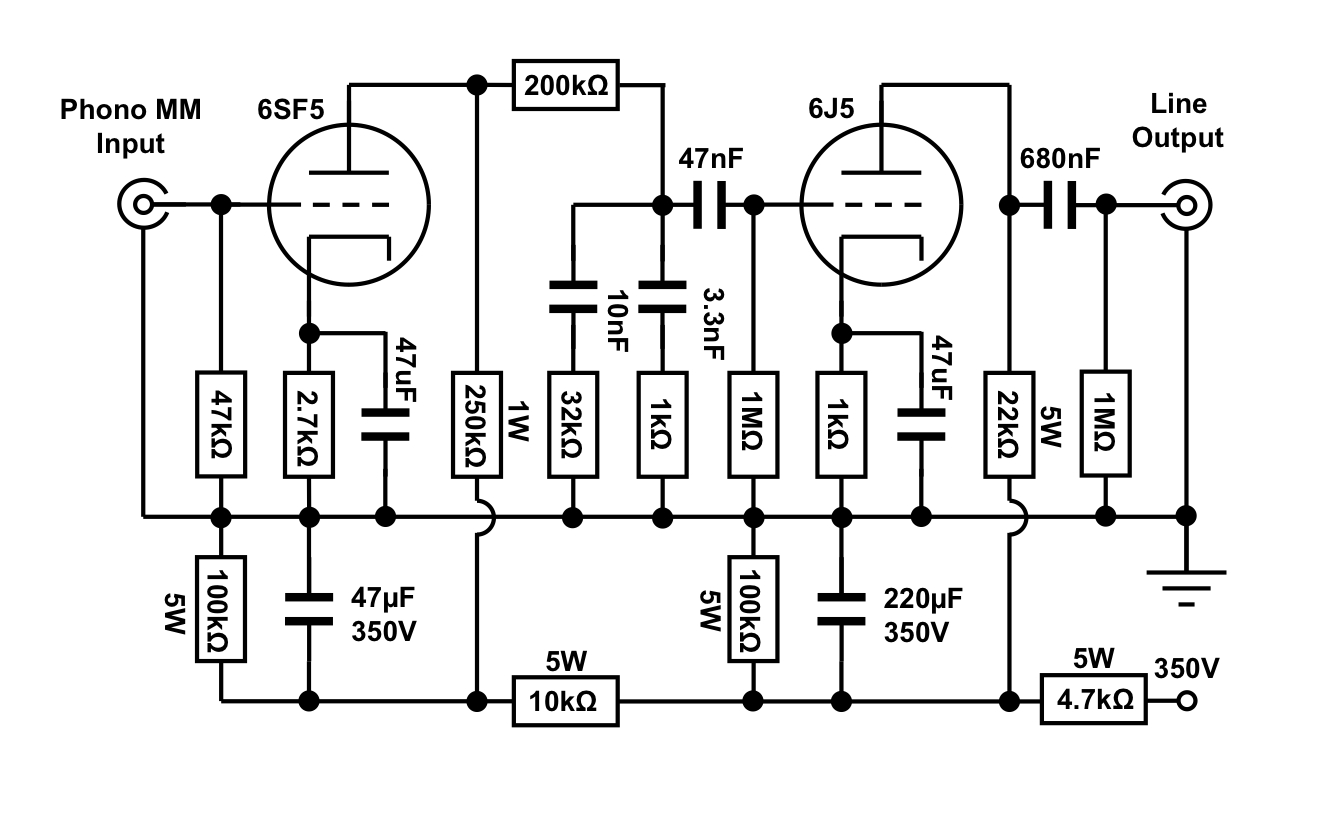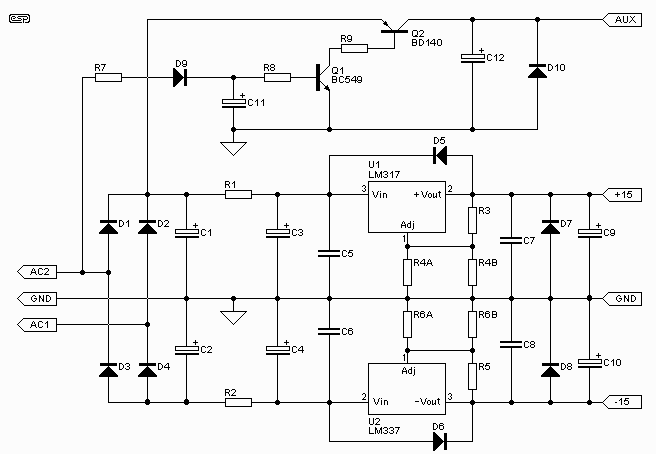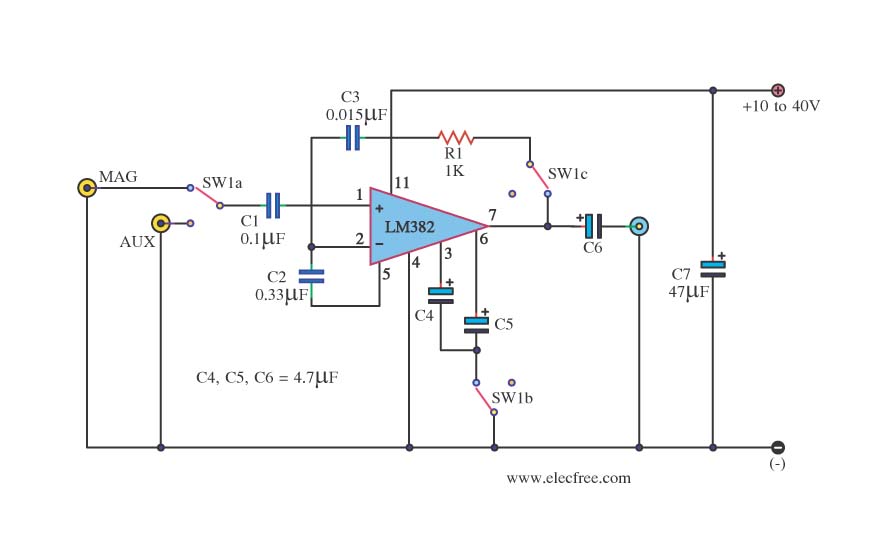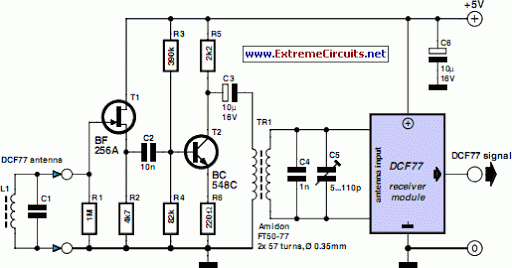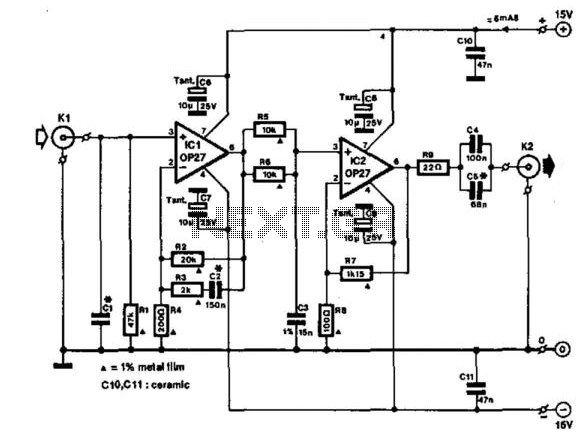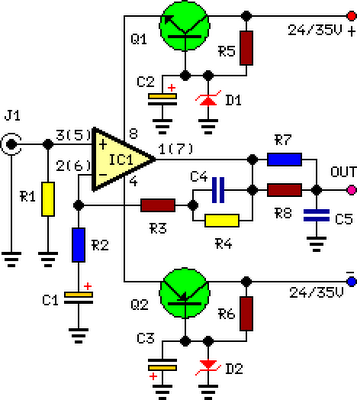
Selectable sensitivity Preamplifier
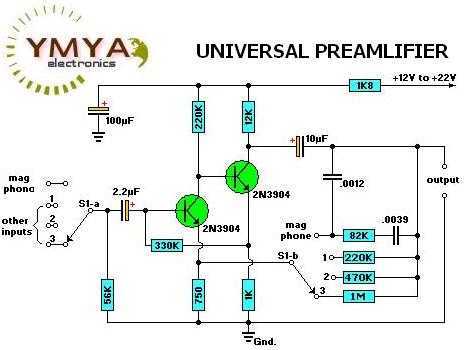
Most audio amplifier systems must have preamplifiers with many different characteristics. These include high-gain linear response for magnetic microphones, low-gain linear response for tuners, and high-gain RIAA equalization for magnetic phone cartridges. To meet this broad requirement, most amplifier designers include a single universal preamplifier circuit. Basically a high-gain linear amplifier, its characteristics can be altered by switching alternative resistor filter networks into its feedback system. For example, when the selector switch is set to the Mag phono position, alternative input sources can be selected by S1-a, and appropriate linear-response gain control feedback resistors 220K, 470K, and 1M are now selected by S1-b. Those feedback resistor values are selected between 10 kilo ohms and 10 megohms to suit individual listener tastes. Circuit gain will be proportional to the feedback resistor value.
The audio amplifier system described employs a universal preamplifier circuit designed to accommodate diverse audio sources with varying gain requirements. At its core, the circuit operates as a high-gain linear amplifier, which is essential for processing signals from different types of audio sources, such as magnetic microphones, tuners, and phonograph cartridges.
The circuit's adaptability is achieved through the integration of a selector switch (S1-a) and a series of feedback resistors (S1-b). When the switch is positioned to the Mag phono setting, it allows the selection of specific input sources while simultaneously enabling the selection of feedback resistors that determine the gain characteristics of the amplifier. The feedback resistors, which include values of 220K, 470K, and 1M ohms, are crucial in defining the circuit's gain response.
The selection of these resistors is not arbitrary; they are chosen based on the desired audio characteristics and the specific requirements of the input source. By varying the resistance between 10 kilo ohms and 10 megohms, the circuit can be finely tuned to match the preferences of individual listeners, ensuring optimal sound quality and performance. The relationship between the feedback resistor value and the circuit gain is direct and proportional, allowing for precise control over amplification levels.
This design approach not only simplifies the amplifier's architecture but also enhances its versatility, making it suitable for a wide range of audio applications. The result is a preamplifier that can seamlessly adapt to different audio sources, providing high-quality sound reproduction tailored to the listener's needs.Most audio amplifier systems must have preamplifiers with many different characteristics. These include high-gain linear response for magnetic microphones, low-gain linear response for tuners, and high-gain RIAA equalization for magnetic phone cartridges. To meet this broad requirement, most amplifier designers include a single universal preamplifier circuit.
Basically a high-gain linear amplifier, its characteristics can be altered by switching alternative resistor filter networks into its feedback system. For example, when the selector switch is set to the Mag phono position, alternative input sources can be selected by S1-a, and appropriate linear-response gain control feedback resistors 220K, 470K, and 1M are now selected by S1-b. Those feedback resistor values are selected between 10 kilo ohms and 10 megohms to suit individual listener tastes.
Circuit gain will be proportional, to the feedback resistor value. 🔗 External reference
The audio amplifier system described employs a universal preamplifier circuit designed to accommodate diverse audio sources with varying gain requirements. At its core, the circuit operates as a high-gain linear amplifier, which is essential for processing signals from different types of audio sources, such as magnetic microphones, tuners, and phonograph cartridges.
The circuit's adaptability is achieved through the integration of a selector switch (S1-a) and a series of feedback resistors (S1-b). When the switch is positioned to the Mag phono setting, it allows the selection of specific input sources while simultaneously enabling the selection of feedback resistors that determine the gain characteristics of the amplifier. The feedback resistors, which include values of 220K, 470K, and 1M ohms, are crucial in defining the circuit's gain response.
The selection of these resistors is not arbitrary; they are chosen based on the desired audio characteristics and the specific requirements of the input source. By varying the resistance between 10 kilo ohms and 10 megohms, the circuit can be finely tuned to match the preferences of individual listeners, ensuring optimal sound quality and performance. The relationship between the feedback resistor value and the circuit gain is direct and proportional, allowing for precise control over amplification levels.
This design approach not only simplifies the amplifier's architecture but also enhances its versatility, making it suitable for a wide range of audio applications. The result is a preamplifier that can seamlessly adapt to different audio sources, providing high-quality sound reproduction tailored to the listener's needs.Most audio amplifier systems must have preamplifiers with many different characteristics. These include high-gain linear response for magnetic microphones, low-gain linear response for tuners, and high-gain RIAA equalization for magnetic phone cartridges. To meet this broad requirement, most amplifier designers include a single universal preamplifier circuit.
Basically a high-gain linear amplifier, its characteristics can be altered by switching alternative resistor filter networks into its feedback system. For example, when the selector switch is set to the Mag phono position, alternative input sources can be selected by S1-a, and appropriate linear-response gain control feedback resistors 220K, 470K, and 1M are now selected by S1-b. Those feedback resistor values are selected between 10 kilo ohms and 10 megohms to suit individual listener tastes.
Circuit gain will be proportional, to the feedback resistor value. 🔗 External reference
